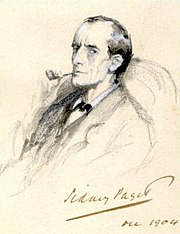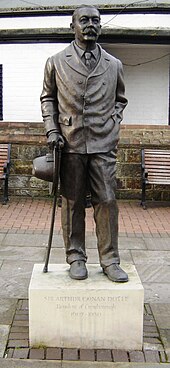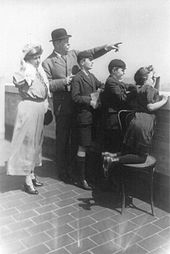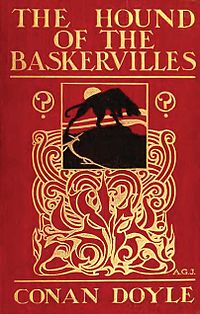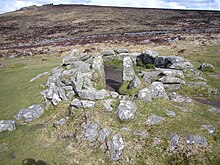Arthur Conan Doyle
|
|
|---|---|
Born
|
Arthur Ignatius Conan Doyle (1859-05-22)22 May 1859 Edinburgh, Scotland |
Died
|
7 July 1930(1930-07-07) (aged 71) Crowborough, East Sussex, England |
Occupation
|
Novelist, short story writer, poet, physician |
Nationality
|
Scottish |
Citizenship
|
British |
Genres
|
Detective fiction, science fiction, historical novels, non-fiction |
Notable work(s)
|
Stories
of Sherlock Holmes The Lost World |
Signature
|
|
Sir Arthur Ignatius Conan Doyle DL (22 May 1859 – 7 July 1930[1]) was a Scottish physician and writer, most noted for his stories about the detective Sherlock Holmes, generally considered a milestone in the field of crime fiction, and for the adventures of Professor Challenger. He was a prolific writer whose other works include science fiction stories, plays, romances, poetry, non-fiction and historical novels.
Life and career
Early life
Arthur Conan Doyle was born on 22 May 1859 at 11 Picardy Place, Edinburgh, Scotland. His father, Charles Altamont Doyle, was English of Irish descent, and his mother, born Mary Foley, was Irish. They married in 1855. In 1864 the family dispersed due to Charles's growing alcoholism and the children were temporarily housed across Edinburgh. In 1867, the family came together again and lived in the squalid tenement flats at 3 Sciennes Place.Supported by wealthy uncles, Conan Doyle was sent to the Roman Catholic Jesuit preparatory school Hodder Place, Stonyhurst, at the age of nine (1868-1870). He then went on to Stonyhurst College until 1875. From 1875 to 1876, he was educated at the Jesuit school Stella Matutina in Feldkirch, Austria.
From 1876 to 1881, he studied medicine at the University of Edinburgh, including a period working in the town of Aston (now a district of Birmingham) and in Sheffield, as well as in Shropshire at Ruyton-XI-Towns. While studying, Conan Doyle began writing short stories. His earliest extant fiction, "The Haunted Grange of Goresthorpe", was unsuccessfully submitted to Blackwood's Magazine. His first published piece "The Mystery of Sasassa Valley", a story set in South Africa, was printed in Chambers's Edinburgh Journal on 6 September 1879. On 20 September 1879, he published his first non-fictional article, "Gelsemium as a Poison" in the British Medical Journal.
Following his term at university, Conan Doyle was employed as a doctor on the Greenland whaler Hope of Peterhead, in 1880, and, after his graduation, as a ship's surgeon on the SS Mayumba during a voyage to the West African coast, in 1881. He completed his doctorate on the subject of tabes dorsalis in 1885.
Doyle's father died in 1893, in the Crichton Royal, Dumfries, after many years of psychiatric illness.
Name
Although Doyle is often referred to as "Conan Doyle", whether this should be considered a compound surname is uncertain. The entry in which his baptism is recorded in the register of St Mary's Cathedral, Edinburgh, gives "Arthur Ignatius Conan" as his Christian names, and simply "Doyle" as his surname. It also names Michael Conan as his godfather. The cataloguers of the British Library and the Library of Congress treat "Doyle" alone as his surname. Steven Doyle, editor of the Baker Street Journal, has writtenConan was Arthur's middle name. Shortly after he graduated from high school he began using Conan as a sort of surname. But technically his last name is simply "Doyle".Nevertheless, the actual use of a compound surname is demonstrated by the fact that Doyle's second wife was known as "Jean Conan Doyle" rather than "Jean Doyle".
Writing career
Portrait of Sherlock Holmes by Sidney Paget, 1904
In 1882 he
joined former classmate George Turnavine Budd as his partner at a
medical practice in Plymouth,
but their relationship proved difficult, and Conan Doyle soon left
to set up an independent practice. Arriving in Portsmouth
in June of that year with less than £10 (£700 today) to his name,
he set up a medical practice at 1 Bush Villas in Elm Grove,
Southsea. The
practice was initially not very successful. While waiting for
patients, Conan Doyle again began writing stories and composed his
first novels, The Mystery of Cloomber,
not published until 1888, and the unfinished Narrative
of John Smith, which would go
unpublished until 2011. He amassed a portfolio of short stories
including "The Captain of the Pole-Star" and "J.
Habakuk Jephson's Statement", both inspired by Doyle's time at
sea.Portrait of Doyle by Herbert Rose Barraud, 1893
Doyle struggled to find a publisher for his work. His first significant piece, A Study in Scarlet, was taken by Ward Lock & Co on 20 November 1886, giving Doyle £25 for all rights to the story. The piece appeared later that year in the Beeton's Christmas Annual and received good reviews in The Scotsman and the Glasgow Herald.[5] The story featured the first appearance of Watson and Sherlock Holmes, partially modelled after his former university teacher Joseph Bell. Conan Doyle wrote to him, "It is most certainly to you that I owe Sherlock Holmes... [R]ound the centre of deduction and inference and observation which I have heard you inculcate I have tried to build up a man." Robert Louis Stevenson was able, even in faraway Samoa, to recognise the strong similarity between Joseph Bell and Sherlock Holmes: "[M]y compliments on your very ingenious and very interesting adventures of Sherlock Holmes. ... [C]an this be my old friend Joe Bell?" Other authors sometimes suggest additional influences—for instance, the famous Edgar Allan Poe character C. Auguste Dupin.
A sequel to A Study in Scarlet was commissioned and The Sign of the Four appeared in Lippincott's Magazine in February 1890, under agreement with the Ward Lock company. Doyle felt grievously exploited by Ward Lock as an author new to the publishing world and he left them. Short stories featuring Sherlock Holmes were published in the Strand Magazine. Sir Arthur Conan Doyle first began to write for the ‘Strand’ from his home at 2 Upper Wimpole Street, now marked by a memorial plaque.
Sporting Career
While living in Southsea, Doyle played football as a goalkeeper for Portsmouth Association Football Club, an amateur side, under the pseudonym A. C. Smith. (This club, disbanded in 1896, had no connection with the present-day Portsmouth F.C., which was founded in 1898.) Conan Doyle was also a keen cricketer, and between 1899 and 1907 he played 10 first-class matches for the Marylebone Cricket Club (MCC). His highest score, in 1902 against London County, was 43. He was an occasional bowler who took just one first-class wicket (although one of high pedigree—it was W. G. Grace). Also a keen golfer, Conan Doyle was elected captain of the Crowborough Beacon Golf Club, East Sussex for 1910. He moved to Little Windlesham house in Crowborough with his second wife Jean Leckie and their family from 1907 until his death in July 1930.Marriages and family
In 1885 Conan Doyle married Louisa (or Louise) Hawkins, known as 'Touie', the sister of one of his patients. She suffered from tuberculosis and died on 4 July 1906. The next year he married Jean Elizabeth Leckie, whom he had first met and fallen in love with in 1897. He had maintained a platonic relationship with Jean while his first wife was still alive, out of loyalty to her. Jean died in London on 27 June 1940.Conan Doyle fathered five children. He had two with his first wife: Mary Louise (28 January 1889 – 12 June 1976) and Arthur Alleyne Kingsley, known as Kingsley (15 November 1892 – 28 October 1918). He also had three with his second wife: Denis Percy Stewart (17 March 1909 – 9 March 1955) second husband of Georgian Princess Nina Mdivani, Adrian Malcolm (19 November 1910 – 3 June 1970) and Jean Lena Annette (21 December 1912 – 18 November 1997).
"Death" of Sherlock Holmes
In 1890 Conan Doyle studied ophthalmology in Vienna, and moved to London, first living in Montague Place and then in South Norwood. He set up a practice as an ophthalmologist. He wrote in his autobiography that not a single patient crossed his door. This gave him more time for writing, and in November 1891 he wrote to his mother: "I think of slaying Holmes... and winding him up for good and all. He takes my mind from better things." His mother responded, "You won't! You can't! You mustn't!"In December 1893, in order to dedicate more of his time to what he considered his more important works (his historical novels), Conan Doyle had Holmes and Professor Moriarty apparently plunge to their deaths together down the Reichenbach Falls in the story "The Final Problem". Public outcry, however, led him to bring the character back in 1901, in The Hound of the Baskervilles, though this was set at a time before the Reichenbach incident. In 1903, Conan Doyle published his first Holmes short story in ten years, "The Adventure of the Empty House", in which it was explained that only Moriarty had fallen; but since Holmes had other dangerous enemies—especially Colonel Sebastian Moran—he had arranged to also be perceived as dead. Holmes ultimately was featured in a total of 56 short stories and four Conan Doyle novels, and has since appeared in many novels and stories by other authors.
Jane Stanford compares some of Moriarty's characteristics to those of the Fenian John O'Connor Power. 'The Final Problem' was published the year the Second Home Rule Bill passed through the House of Commons. 'The Valley of Fear' was serialised in 1914, the year, Home Rule, The Government of Ireland Act (Sept.18) was placed on the Statute Book.
Political campaigning
Arthur Conan Doyle's house in South Norwood, LondonFollowing the Boer War in South Africa at the turn of the 20th century and the condemnation from around the world over the United Kingdom's conduct, Conan Doyle wrote a short pamphlet titled The War in South Africa: Its Cause and Conduct, which justified the UK's role in the Boer War and was widely translated. Doyle had served as a volunteer doctor in the Langman Field Hospital at Bloemfontein between March and June 1900.
Conan Doyle believed it was this pamphlet that resulted in his being knighted by King Edward VII in 1902 and appointed a Deputy-Lieutenant of Surrey. Also in 1900 he wrote a book, The Great Boer War. During the early years of the 20th century, he twice stood for Parliament as a Liberal Unionist—once in Edinburgh and once in the Hawick Burghs—but although he received a respectable vote, he was not elected.
Conan Doyle was a supporter of the campaign for the reform of the Congo Free State, led by the journalist E. D. Morel and the diplomat Roger Casement. During 1909 he wrote The Crime of the Congo, a long pamphlet in which he denounced the horrors of that colony. He became acquainted with Morel and Casement, and it is possible that, together with Bertram Fletcher Robinson, they inspired several characters in the 1912 novel The Lost World.[ However, Doyle broke with both Morel and Casement when Morel became one of the leaders of the pacifist movement during the First World War. When Casement was found guilty of treason against the Crown during the Easter Rising, Doyle tried unsuccessfully to save him from facing the death penalty, arguing that Casement had been driven mad and could not be held responsible for his actions.
Correcting injustice
Arthur Conan Doyle statue in Crowborough, East SussexConan Doyle was also a fervent advocate of justice and personally investigated two closed cases, which led to two men being exonerated of the crimes of which they were accused. The first case, in 1906, involved a shy half-British, half-Indian lawyer named George Edalji who had allegedly penned threatening letters and mutilated animals. Police were set on Edalji's conviction, even though the mutilations continued after their suspect was jailed.
It was partially as a result of this case that the Court of Criminal Appeal was established in 1907, so not only did Conan Doyle help George Edalji, his work helped establish a way to correct other miscarriages of justice. The story of Conan Doyle and Edalji was fictionalised in Julian Barnes's 2005 novel Arthur & George and dramatized in an episode of the 1972 BBC television series, "The Edwardians". In Nicholas Meyer's pastiche The West End Horror (1976), Holmes manages to help clear the name of a shy Parsee Indian character wronged by the English justice system. Edalji himself was of Parsee heritage on his father's side.
The second case, that of Oscar Slater, a German Jew and gambling-den operator convicted of bludgeoning an 82-year-old woman in Glasgow in 1908, excited Conan Doyle's curiosity because of inconsistencies in the prosecution case and a general sense that Slater was not guilty. He ended up paying most of the costs for Slater's successful appeal in 1928.
Spiritualism
One of the five photographs of Frances Griffiths with
the alleged fairies, taken by Elsie Wright in July 1917
Following the death of his wife Louisa in 1906,
the death of his son Kingsley just before the end of World
War I, and the deaths of his brother Innes, his two
brothers-in-law (one of whom was E.
W. Hornung, creator of the literary character Raffles)
and his two nephews shortly after the war, Conan Doyle sank into
depression. He found solace supporting spiritualism
and its attempts to find proof of existence beyond the grave. In
particular, according to some, he favoured Christian
Spiritualism and encouraged the Spiritualists'
National Union to accept an eighth precept – that of
following the teachings and example of Jesus
of Nazareth. He also was a member of the renowned paranormal
organisation The
Ghost Club. Its focus, then and now, is on the scientific study
of alleged paranormal activities in order to prove (or refute) the
existence of paranormal phenomena.On 28 October 1918 Kingsley Doyle died from pneumonia, which he contracted during his convalescence after being seriously wounded during the 1916 Battle of the Somme. Brigadier-General Innes Doyle died, also from pneumonia, in February 1919. Sir Arthur became involved with Spiritualism to the extent that he wrote a Professor Challenger novel on the subject, The Land of Mist.
His book The Coming of the Fairies (1921) shows he was apparently convinced of the veracity of the five Cottingley Fairies photographs (which decades later were exposed as a hoax). He reproduced them in the book, together with theories about the nature and existence of fairies and spirits. In The History of Spiritualism (1926), Conan Doyle praised the psychic phenomena and spirit materialisations produced by Eusapia Palladino and Mina "Margery" Crandon.
Conan Doyle with his family in New York City, 1922
Conan Doyle was friends for a time with Harry
Houdini, the American magician who himself became a prominent
opponent of the Spiritualist movement in the 1920s following the
death of his beloved mother. Although Houdini insisted that
Spiritualist mediums employed trickery (and consistently exposed
them as frauds), Conan Doyle became convinced that Houdini himself
possessed supernatural powers—a view expressed in Conan Doyle's
The Edge of the Unknown.
Houdini was apparently unable to convince Conan Doyle that his
feats were simply illusions, leading to a bitter public falling out
between the two.Richard Milner, an American historian of science, has presented a case that Conan Doyle may have been the perpetrator of the Piltdown Man hoax of 1912, creating the counterfeit hominid fossil that fooled the scientific world for over 40 years. Milner says that Conan Doyle had a motive—namely, revenge on the scientific establishment for debunking one of his favourite psychics—and that The Lost World contains several encrypted clues regarding his involvement in the hoax.
Samuel Rosenberg's 1974 book Naked is the Best Disguise purports to explain how, throughout his writings, Conan Doyle left open clues that related to hidden and suppressed aspects of his mentality.
Death
Grave of Sir Arthur Conan Doyle at Minstead, EnglandConan Doyle was found clutching his chest in the hall of Windlesham Manor, his house in Crowborough, East Sussex, on 7 July 1930. He died of a heart attack at the age of 71. His last words were directed toward his wife: "You are wonderful."At the time of his death, there was some controversy concerning his burial place, as he was avowedly not a Christian, considering himself a Spiritualist. He was first buried on 11 July 1930 in Windlesham rose garden. He was later reinterred together with his wife in Minstead churchyard in the New Forest, Hampshire. Carved wooden tablets to his memory and to the memory of his wife are held privately and are inaccessible to the public. That inscription reads, "Blade straight / Steel true / Arthur Conan Doyle / Born May 22nd 1859 / Passed On 7th July 1930." The epitaph on his gravestone in the churchyard reads, in part: "Steel true/Blade straight/Arthur Conan Doyle/Knight/Patriot, Physician, and man of letters".
Undershaw, the home near Hindhead, Haslemere, south of London, that Arthur Conan Doyle had built and lived in between October 1897 and September 1907, was a hotel and restaurant from 1924 until 2004. It was then bought by a developer and stood empty while conservationists and Conan Doyle fans fought to preserve it. In 2012 the High Court ruled that the redevelopment permission be quashed because proper procedure had not been followed.
A statue honours Conan Doyle at Crowborough Cross in Crowborough, where he lived for 23 years. There is also a statue of Sherlock Holmes in Picardy Place, Edinburgh, close to the house where Conan Doyle was born


